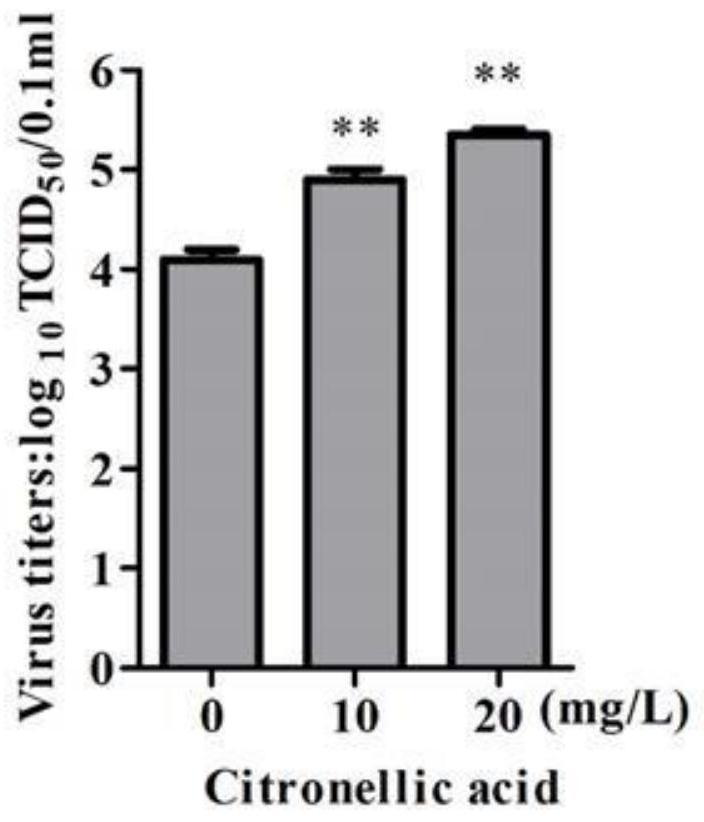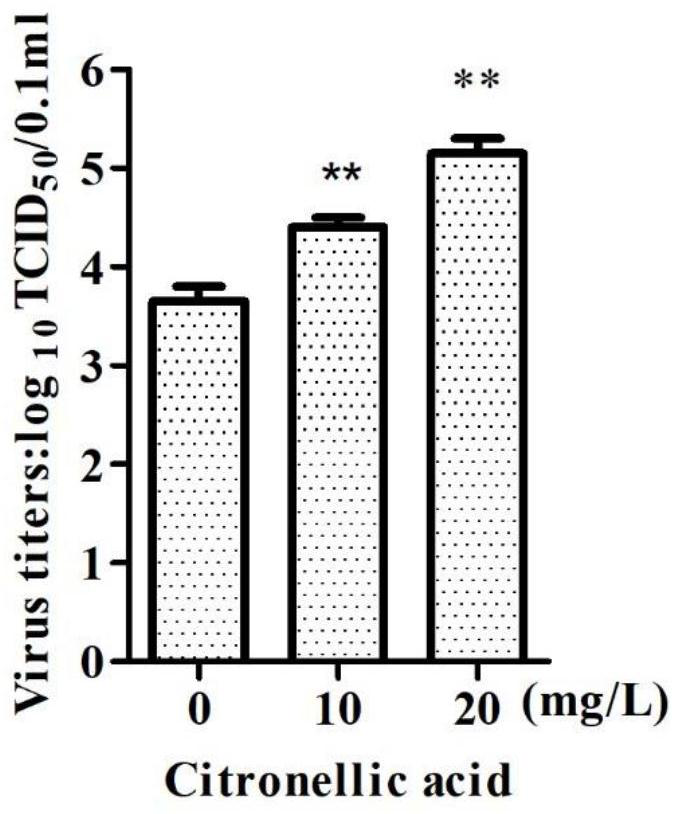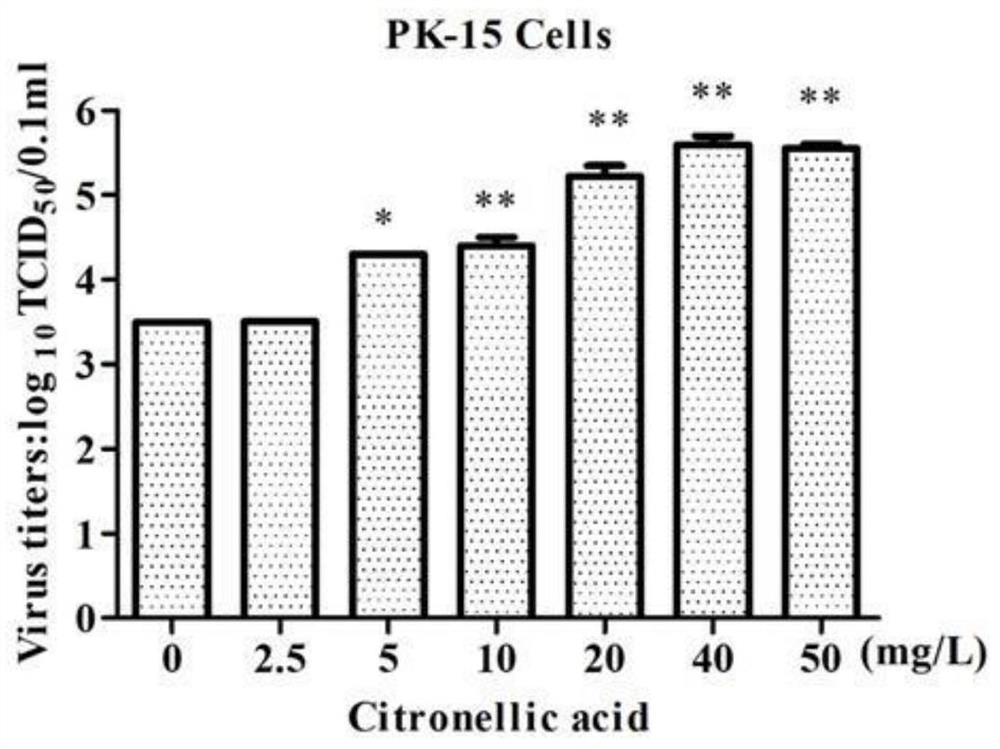The Application of Citronellic Acid as a Synergist in Vaccine Production
A technology of citronellic acid and synergist, which is applied in the field of application of citronellic acid as a synergist in the production of viruses or virus vaccines, to achieve the effects of high-efficiency production, increased replication level, and promotion of SVA replication
- Summary
- Abstract
- Description
- Claims
- Application Information
AI Technical Summary
Problems solved by technology
Method used
Image
Examples
Embodiment 1
[0028] Embodiment 1 Citronellic acid promotes the effect evaluation experiment of SVA replication
[0029] 1. Preparation of Medium Containing Citronellic Acid
[0030] In DMEM medium, different doses of citronellic acid were added to make the concentrations 0mg / L, 10mg / L and 20mg / L respectively.
[0031] 2. Sample Preparation of Citronellic Acid-Incubated Cells
[0032] The IB cells were incubated with the prepared medium containing citronellic acid, then inoculated with SVA / FJ-201 (1 MOI), and the supernatant was collected 8 hours after inoculation.
[0033] 3. Determination of SVA virus titer
[0034] Determine the TCID of the supernatant obtained in the previous step 50 , for virus titer analysis.
[0035] TCID 50 The assay steps are as follows: inoculate the IB cells into a 96-well plate 16 hours in advance, wash the IB cells with PBS 3 times after the cells form a monolayer, and inoculate the supernatant collected in step 2 (10 -1 -10 -10 ) were used as infection ...
Embodiment 2
[0037] Embodiment 2 Citronellic acid promotes the effect evaluation experiment of SVA replication
[0038] 1. Preparation of Medium Containing Citronellic Acid
[0039] In DMEM medium, different doses of citronellic acid were added to make the concentrations 0mg / L, 10mg / L and 20mg / L respectively.
[0040] 2. Sample Preparation of Citronellic Acid-Incubated Cells
[0041] The PK-15 cells were incubated with the prepared medium containing citronellic acid, then inoculated with SVA / FJ-201 (1 MOI), and the supernatant was collected 12 hours after inoculation.
[0042] 3. Determination of SVA virus titer
[0043] After infection with SVA, the cell supernatant was collected and measured by TCID50 for virus titer analysis. Determination of virus titer: IB cells were inoculated into a 96-well plate 16 hours in advance. After the cells formed a monolayer, the IB cells were washed 3 times with PBS, and the supernatant collected in step 2 (10 -1 -10 -10 ), and set up two columns of ...
Embodiment 3
[0045] The citronellic acid of embodiment 3 different concentrations promotes the duplication of SVA in PK-15 or IB cell
[0046] 1. Preparation of Medium Containing Citronellic Acid
[0047] In the DMEM medium, different doses of citronellic acid were added to make the concentrations respectively 0mg / L, 2.5mg / L, 5mg / L, 10mg / L, 20mg / L, 40mg / L and 50mg / L.
[0048] 2. Sample Preparation of Citronellic Acid-Incubated Cells
[0049] Incubate PK-15 cells with the prepared medium containing the above-mentioned different concentrations of citronellic acid, then inoculate SVA (1MOI), and collect the supernatant 12 hours after inoculation;
[0050] At the same time, the IB cells were incubated with the prepared medium containing the above-mentioned different concentrations of citronellic acid, then inoculated with SVA (1 MOI), and the supernatant was collected 8 hours after inoculation.
[0051] 3. Determination of SVA virus titer
[0052]Cell supernatants were collected after infec...
PUM
 Login to View More
Login to View More Abstract
Description
Claims
Application Information
 Login to View More
Login to View More - R&D
- Intellectual Property
- Life Sciences
- Materials
- Tech Scout
- Unparalleled Data Quality
- Higher Quality Content
- 60% Fewer Hallucinations
Browse by: Latest US Patents, China's latest patents, Technical Efficacy Thesaurus, Application Domain, Technology Topic, Popular Technical Reports.
© 2025 PatSnap. All rights reserved.Legal|Privacy policy|Modern Slavery Act Transparency Statement|Sitemap|About US| Contact US: help@patsnap.com



